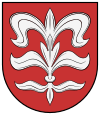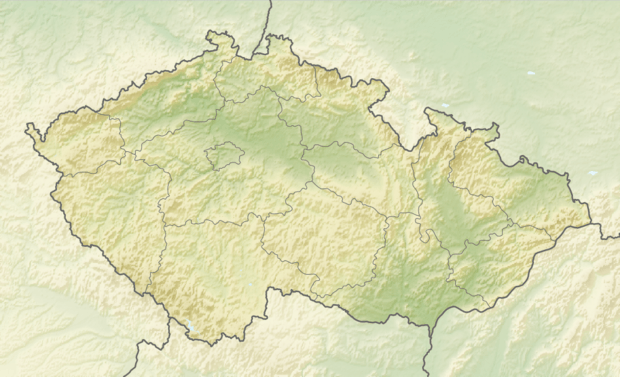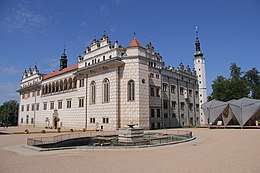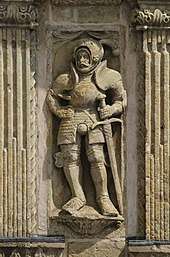Litomyšl
Litomyšl ([ˈlɪtomɪʃl̩] (![]()
Litomyšl | |
|---|---|
Town | |
 Marketplace at Litomyšl | |
 Flag  Coat of arms | |
 Litomyšl Location in the Czech Republic | |
| Coordinates: 49°52′12″N 16°18′46″E | |
| Country | |
| Region | Pardubice |
| District | Svitavy |
| First mentioned | 981 |
| Government | |
| • Mayor | Daniel Brýdl |
| Area | |
| • Total | 33.45 km2 (12.92 sq mi) |
| Elevation | 330 m (1,080 ft) |
| Population (2019-01-01[1]) | |
| • Total | 10,429 |
| • Density | 310/km2 (810/sq mi) |
| Time zone | UTC+1 (CET) |
| • Summer (DST) | UTC+2 (CEST) |
| Postal code | 570 01 |
| Website | www.litomysl.cz |
 | |
| Official name | Litomyšl Castle |
| Criteria | Cultural: (ii)(iv) |
| Reference | 901 |
| Inscription | 1999 (23rd session) |
| Area | 4.25 ha (0.0164 sq mi) |
| Buffer zone | 118.13 ha (0.4561 sq mi) |
| Website | www |
The château-type castle complex in the town centre is an UNESCO World Heritage Site.
History
The town takes its name from the Litoměřici, one of more than a dozen West Slavic tribes who settled in the Czech lands from the sixth century.[2]
The eastern Bohemian town of Litomyšl emerged in the 13th century on the site of an older fortified settlement on the Trstenice path - an important trading route linking Bohemia and Moravia.
From 30 April 1344 till its suppression in 1474 in the Hussite Wars the town was the seat of a Latin Catholic Diocese of Leitomischl / Litomyšl / Lutomislen(sis) (Latin adjective), until its territory was merged back into the (meanwhile Metropolitan Arch)Diocese of Prague. In 1970 it was nominally restored as Titular bishopric.[3]
Until 1918 Leitomischl–Litomyšl (older German name Leutomischl) was part of the Austrian monarchy (Austrian side after the compromise of 1867), head of the district with the same name, one of the 94 Bezirkshauptmannschaften or "okresní hejtmanství" in Bohemia.[4]
Litomyšl had a Jewish community until 1942, when it was deported in The Holocaust. Litomyšl's synagogue survived until the 1960s, when it was demolished and an apartment block was built in its place.
Litomyšl had a German-speaking community until it was expelled in 1945 as a result of the Beneš decrees.
Main sights
The dominant feature of Litomyšl is the monumental Renaissance castle built in the years 1568–81. The buildings of the castle precincts are exceptional not only for their architectural refinement, but have also as the birthplace of the Czech composer Bedřich Smetana.

On the elongated square, which is one of the largest in the Czech Republic, is a town hall of Gothic origin and a series of Renaissance and baroque houses, many with arcades and vaulted ground floor rooms. One of the most important houses is Dům U rytířů ("the House of the Knights"), a 16th-century building with a notable stone façade.
In the past the town was also a significant religious centre. It was in Litomyšl in 1344 that the second bishopric to be established in Bohemia was founded, although it ceased to exist in the Hussite Wars.
In the 19th century the Litomyšl Grammar School was of great importance.
The cultural traditions of the town go far beyond regional and national frontiers. The exquisite interiors of the castle, especially the baroque castle theatre, the amphitheatre in the castle park and Smetana House, all offer varied programmes of concerts and theatrical performances and thus enrich the life of the town throughout the year. In 1994 the meeting of the seven Central European presidents was held at the castle. The chateau complex was added to the UNESCO World Heritage List in 1999.
Litomyšl is also home to the "Portmoneum", a museum of the artist and writer Josef Váchal in the home of his admirer Josef Portman, who commissioned Váchal's murals and painted furniture in the house.
Municipal subdivisions
- Litomyšl-město
- Kornice
- Lány
- Nedošín
- Nová Ves u Litomyšle
- Pazucha
- Pohodlí
- Suchá
- Zahájí
- Záhradí
Broadcasting station
Near Litomyšl is a large broadcasting station for short and medium wave. The short wave transmitter at 49°49′07″N 16°18′27″E is the most important short wave broadcasting facility of Czech using towers with heights up to 105 metres (344 ft). Slightly southeast at 49°48′38″N 16°18′5″E are two guyed masts, 125 metres (410 ft) tall, used for medium wave broadcasting on 1287 kHz with 150 kW[5]
Notable people
.jpg)
- Magdalena Dobromila Rettigová (1785–1845), author of the first cookbook written in Czech, lived here in 1834–1845
- August Jilek (1819–98) physician and oceanographer
- Bedřich Smetana (1824–84), classical composer
- Josef Kořenský (1847–1938), one of the most prominent Czech travellers, worked in Litomyšl as a teacher in 1871–1874
- Hubert Gordon Schauer (1862–92), writer and literary critic
- Arne Novák (1880–1939), critic and historian of literature
- Karel Píč (1920–95), Esperanto writer, author of the innovative autobiographical novel La Litomiŝla Tombejo (The Litomyšl Cemetery)
There is an extensive permanent exhibition of Olbram Zoubek's (a famous Czech contemporary sculptor and designer) sculptures and art in Litomyšl Castle Vault Gallery.
Twin towns — sister cities
Litomyšl is twinned with:[6]
See also
References
- "Population of municipalities of the Czech republic". Czech Statistical Office. Retrieved 30 April 2019.
- "Czech Republic (Czechia)". World Statesmen.
- "Titular Episcopal See of Litomyšl Czechia". GCatholic.
- Klein, Wilhelm (1967). Die postalischen Abstempelungen auf den österreichischen Postwertzeichen-Ausgaben 1867, 1883 und 1890.
- "Technical broadcasting data" (GIF) (in Czech). Retrieved 28 November 2014.
- "Partnerská města" (in Czech). Město Litomyšl. Retrieved 25 August 2019.
External links
| Wikimedia Commons has media related to Litomyšl. |
- Official website (in Czech)
- English version of municipal website
- Basic facts, sights, history
- GCatholic - former/titular diocese
- World Statesmen